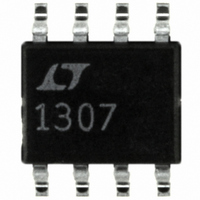LT1307CS8#PBF Linear Technology, LT1307CS8#PBF Datasheet - Page 10

LT1307CS8#PBF
Manufacturer Part Number
LT1307CS8#PBF
Description
IC DC/DC CONV SINGLE CELL 8-SOIC
Manufacturer
Linear Technology
Type
Step-Up (Boost)r
Datasheet
1.LT1307CS8PBF.pdf
(20 pages)
Specifications of LT1307CS8#PBF
Internal Switch(s)
Yes
Synchronous Rectifier
No
Number Of Outputs
1
Voltage - Output
3.3V, 5V
Current - Output
100mA
Frequency - Switching
600kHz
Voltage - Input
1 ~ 5 V
Operating Temperature
-40°C ~ 85°C
Mounting Type
Surface Mount
Package / Case
8-SOIC (3.9mm Width)
Primary Input Voltage
5V
No. Of Outputs
1
Output Voltage
28V
Output Current
100mA
No. Of Pins
8
Operating Temperature Range
0°C To +70°C
Msl
MSL 1 - Unlimited
Switching Frequency Max
600kHz
Rohs Compliant
Yes
Lead Free Status / RoHS Status
Lead free / RoHS Compliant
Power - Output
-
Available stocks
Company
Part Number
Manufacturer
Quantity
Price
APPLICATIO S I FOR ATIO
LT1307/LT1307B
away from 455kHz. Figure 8 shows the noise spectrum of
the converter with the load increased to 20mA. The
LT1307 shifts out of Burst Mode operation, eliminating
low frequency ripple. Spectral energy is present only at
the switching fundamental and its harmonics. Noise
voltage measures – 5dBmV
575kHz switching frequency, and is below – 60dBmV
for all other frequencies in the range. By combining Burst
Mode with fixed frequency operation, the LT1307 keeps
noise away from 455kHz.
10
Figure 9. LT1307B at 5mA Load Shows No Audio Components
or Sidebands About Switching Frequency, 333kHz
Fundamental Amplitude is –10dBmV, or 316 V
Figure 8. With Converter Delivering 20mA, Low Frequency
Sidebands Disappear. Noise is Present Only at the 575kHz
Switching Frequency
–100
–100
–10
–20
–30
–40
–50
–60
–70
–80
–90
–10
–20
–30
–40
–50
–60
–70
–80
–90
0
255
0
205
RBW = 100Hz
U
FREQUENCY (kHz)
FREQUENCY (kHz)
U
455
455
RMS
W
or 560 V
LT1307 • F09
1307 F08
655
705
RMS
RMS
U
at the
RMS
To eliminate the low frequency noise of Figure 6, the
LT1307 can be replaced with the LT1307B. Figure 9
details the spectral noise at the output of Figure 1’s circuit
using an LT1307B at 5mA load. Although spectral energy
is present at 333kHz due to alternate pulse skipping, all
Burst Mode operation spectral components are gone.
Alternate pulse skipping can be eliminated by increasing
inductance.
FREQUENCY COMPENSATION
Obtaining proper values for the frequency compensation
network is largely an empirical, iterative procedure, since
variations in input and output voltage, topology, capacitor
value and ESR, and inductance make a simple formula
elusive. As an example, consider the case of a 1.25V to
3.3V boost converter supplying 50mA. To determine
optimum compensation, the circuit is built and a transient
load is applied to the circuit. Figure 10 shows the setup.
Figure 11a details transient response without compensa-
tion components. Although the output ripple voltage at a
1mA load is low, allowing the error amplifier to operate
wideband results in excessive ripple at a 50mA load. Some
kind of loop stabilizing network is obviously required. A
100k/22nF series RC is connected to the V
in the response pictured in Figure 11b. The output settles
in about 7ms to 8ms. This may be acceptable, but we can
do better. Reducing C to 2nF gives Figure 11c’s response.
This is clearly in the right direction. After another order of
magnitude reduction, Figure 11d’s response shows some
*CERAMIC
1 F
1.25V
Figure 10. Boost Converter with Simulated Load
R
C
SHDN
V
C
V
IN
LT1307
10 H
GND
SW
FB
MBR0520L
1M
590k
3300
10 F*
C
pin, resulting
66
V
OUT
1307 • F10
50
1307fa













